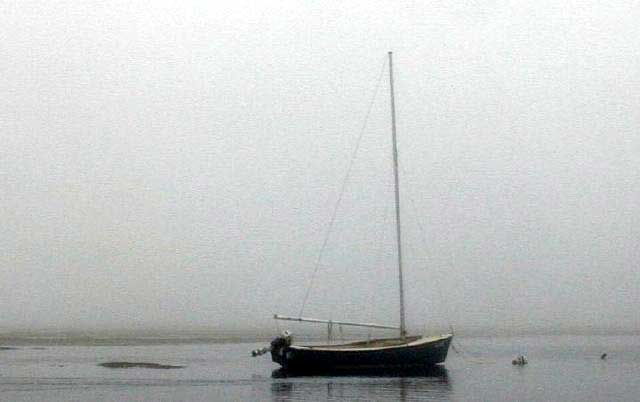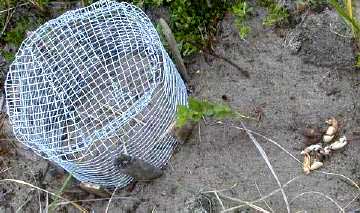Who’s Teaching Whom? — 22 June 2001
Fog bathed the Cape in grays and whites as dawn broke on the first full day of summer in the Land of Ooze. Nesting activity picked up a bit from its quiet interlude, but our big flood tide remains deep at night and it will take a few more days before the next wave crests.

The morning brought one coincidence so strange it still hurts my head trying to demystify this chicken & egg dilemma. Last year, Mass Audubon, with the help of generous local contributors, purchased an undeveloped parcel of land, which juts into Fresh Brook with a wonderful southerly exposure. A key goal was to preserve this upland site as nesting grounds for the threatened diamondback terrapin. We had yet to confirm nesting activity on Doctors Hill, but it seemed like such a perfect spot with all the critical supporting elements of access, developmental marsh, seclusion, and good sun orientation. Without confirmed nesting already on site, we decided to relocate partially preyed-upon and vulnerable nests to this locale — to kick-start the process. Yesterday, we found a nearby nest on Lieutenant Island that had been dug below the flood tide mark. We harvested the viable eggs and relocated them to Doctors Hill. I picked a spot that just “seemed right” — if I were a terrapin, that is. We field marked the nest, so we could return this morning with a nest protector.
  Our hearts dropped as we approached the site, because we could see the remains of eggs scattered near the field markings. Had we lost this relocated nest overnight before we could install a permanent protector? Nope — close examination revealed the relocated nest was fully intact and still contained 12 viable eggs. Instead, we discovered a natural terrapin nest that had been preyed upon within a foot of the relocated nest. Evidence indicates that this nest had been laid yesterday afternoon or evening — after we had dug our own nest on the site. Wow! Our hearts dropped as we approached the site, because we could see the remains of eggs scattered near the field markings. Had we lost this relocated nest overnight before we could install a permanent protector? Nope — close examination revealed the relocated nest was fully intact and still contained 12 viable eggs. Instead, we discovered a natural terrapin nest that had been preyed upon within a foot of the relocated nest. Evidence indicates that this nest had been laid yesterday afternoon or evening — after we had dug our own nest on the site. Wow!
This preyed-upon nest represents the first confirmed nesting activity on Doctors Hill. Questions ring. Had turtles been nesting here all along, and had we just missed any confirmatory signs? If there had been no previous nesting, what drove this female to nest within a foot of our artificial/relocated nest? Have we learned so well from terrapins that we can spot a nesting site without any signs? Or have the turtles followed our tracks/scents to nest at this new site? In other words, which came first, the turtle or the egg?
   We had a sad loss today. Terrapin 368, who has been observed by researchers since the summer of 1996, was found dead in the wrack off Indian Neck. She had been spotted nesting at this precise site on 16 June, just six days ago. She was healthy and active and quite aggressive (left photo). This morning her carapace (right photo) had scratches and scrapes not present on the 16th, and all her limbs were missing, both indicating an attack by a predator. We had a sad loss today. Terrapin 368, who has been observed by researchers since the summer of 1996, was found dead in the wrack off Indian Neck. She had been spotted nesting at this precise site on 16 June, just six days ago. She was healthy and active and quite aggressive (left photo). This morning her carapace (right photo) had scratches and scrapes not present on the 16th, and all her limbs were missing, both indicating an attack by a predator.
 |
|
On a much happier note, one of the younger and more energetic members of the Paludal Posse discovered her first terrapin on a nesting run to the barrier hook of Lieutenant Island in the shadow of the north osprey pole. This 10-year-old female — the turtle, that is — sported a very dark carapace and plastron, and a pronounced mustache. The other one sported a most winning smile. |
|